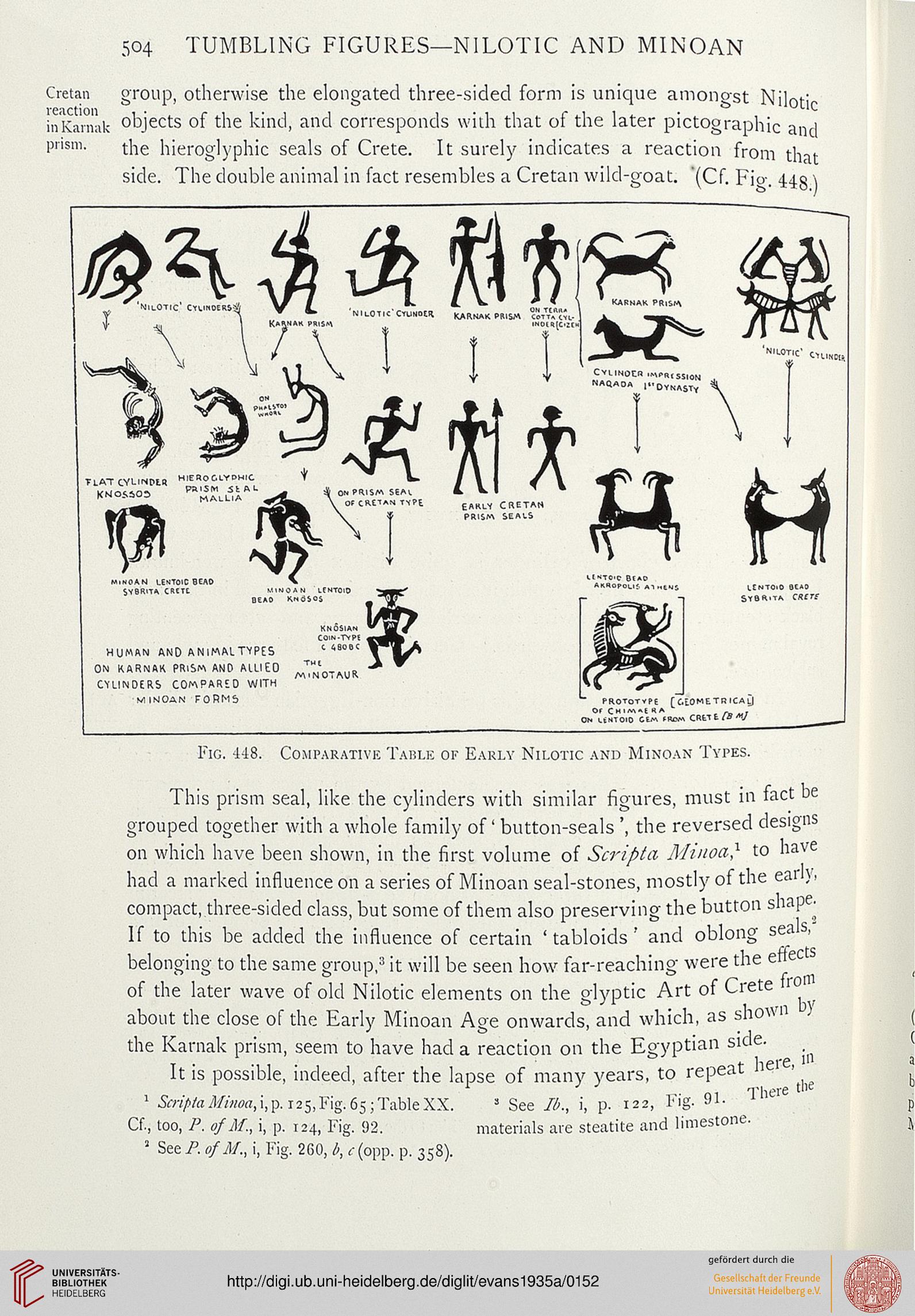504 TUMBLING FIGURES—NILOTIC AND MINOAN
j-eun group, otherwise the elongated three-sided form is unique amongst Nilotic
nKarnak objects of the kind, and corresponds with that of the later pictography and
irism. the hieroglyphic seals of Crete. It surely indicates a reaction from that
side. The double animal in fact resembles a Cretan wild-goat. '(Cf. Fig. 44g \
i\ i I r
EARLW CRETAN
HUMAN AND ANIfAAL TYPES
ON KARNAK PRiSn. AND ALLIED
CYLINDERS COMPARED WITH
MINOAN FORMS
[GEOMETRICAL!
Fig. 448. Comparative Table of Early Nilotic and Minoan Types.
This prism seal, like the cylinders with similar figures, must in fact be
grouped together with a whole family of' button-seals ', the reversed designs
on which have been shown, in the first volume of Scripta Mi/ioa,1 to nave
had a marked influence on a series of Minoan seal-stones, mostly of the ear},
compact.three-sided class, but some of them also preserving the button snap •
If to this be added the influence of certain ' tabloids ' and oblong sea s,
belonging to the same group,3 it will be seen how far-reaching were the ene
of the later wave of old Nilotic elements on the glyptic Art of Crete i ^
about the close of the Early Minoan Age onwards, and which, as shown
the Karnak prism, seem to have had a reaction on the Egyptian side.
t- here
It is possible, indeed, after the lapse of many years, to repeat
1 &-<)WaM»?iJ,i,p.i25,Fig:65;TableXX. s See lb., i, p. 122, F'g- 91'
Cf., too, P. of ML, i, p. 124, Fig. 92. materials are steatite and limestone.
1 See P. ofM., i, Fig. 260, b, <r(opp. p. 358).
the
j-eun group, otherwise the elongated three-sided form is unique amongst Nilotic
nKarnak objects of the kind, and corresponds with that of the later pictography and
irism. the hieroglyphic seals of Crete. It surely indicates a reaction from that
side. The double animal in fact resembles a Cretan wild-goat. '(Cf. Fig. 44g \
i\ i I r
EARLW CRETAN
HUMAN AND ANIfAAL TYPES
ON KARNAK PRiSn. AND ALLIED
CYLINDERS COMPARED WITH
MINOAN FORMS
[GEOMETRICAL!
Fig. 448. Comparative Table of Early Nilotic and Minoan Types.
This prism seal, like the cylinders with similar figures, must in fact be
grouped together with a whole family of' button-seals ', the reversed designs
on which have been shown, in the first volume of Scripta Mi/ioa,1 to nave
had a marked influence on a series of Minoan seal-stones, mostly of the ear},
compact.three-sided class, but some of them also preserving the button snap •
If to this be added the influence of certain ' tabloids ' and oblong sea s,
belonging to the same group,3 it will be seen how far-reaching were the ene
of the later wave of old Nilotic elements on the glyptic Art of Crete i ^
about the close of the Early Minoan Age onwards, and which, as shown
the Karnak prism, seem to have had a reaction on the Egyptian side.
t- here
It is possible, indeed, after the lapse of many years, to repeat
1 &-<)WaM»?iJ,i,p.i25,Fig:65;TableXX. s See lb., i, p. 122, F'g- 91'
Cf., too, P. of ML, i, p. 124, Fig. 92. materials are steatite and limestone.
1 See P. ofM., i, Fig. 260, b, <r(opp. p. 358).
the





